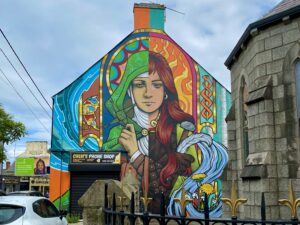In Ireland, the first day of February is St. Brigid’s Day, as well as the ancient Celtic holiday of Imbolc, marking new birth and the threshold of spring. It has just recently been christened as a government holiday in Ireland (St. Patrick’s Day became “official” there in 1903). The occasion is a celebration for both Christians and those who observe pre-Christian Gaelic traditions.
Over the summer, I was mesmerized by this mural depicting Brigid in Dundalk – halfway between Belfast and Dublin on Ireland’s east coast. After my vacation, I read up on the hagiography of this woman who died almost 1,500 years ago.
St. Brigid is said to be the child of a pagan chieftain and a Christian slave. It is thought that her father named his daughter after Brigid, the Celtic goddess of healing, fire, and poetry. The two-story mural in Dundalk attempted to portray both Brigids.
Because of the time period, there are many details that we do not know. What has been passed down is that Saint Brigid (451-525) was a winsome and compassionate founder of one of Ireland’s most important and remarkable dual monasteries for both nuns and monks. The Abbey at Kildare – 40 miles west of Dublin – was known for its hospitality, as well as its emphasis on art, metalwork, and “illuminated manuscripts” similar to the world-renowned Book of Kells. Unfortunately, the Book of Kildare is lost to history, and the Abbey at Kildare was destroyed in the 12th century.
“This woman therefore grew in exceptional virtues and by the fame of her good deeds drew to herself from all the provinces of Ireland inestimable number of people of both sexes…” wrote Cogitosus (c. 650), a monk of Kildare, in his remembrance of St. Brigid. “On the firm foundation of faith she established her monastery … which is the head of almost all the churches of Ireland and holds the place of honor among all the monasteries of the Irish.”
Because of her prominence, St. Brigid is also one of the three patron saints of Ireland, alongside St. Patrick and St. Columcille.
There are numerous stories of her faith and tenderheartedness. As a child, she gave away butter and bacon to those who were hungry (including a whimpering dog). She is said to have also given away her father’s jewel-encrusted sword to a beggar in need – much to her father’s frustration and exasperation. After trying to sell her off, he finally realized that allowing her to live a life devoted to her faith made far more sense.
St. Brigid is most well-known for weaving a cross from straw or reeds while at the deathbed of a pagan chieftain who had grown delirious with his illness. As she sat with him, she weaved a cross and explained its meaning. In some versions of the story, it is said that it brought peace to the man’s heart and he sought baptism before his final breath.
In his remembrance of her kindness, generosity, and miraculous life, Cogitosus did not fail to mention the time Brigid turned bathwater into beer. “On another extraordinary occasion some lepers asked this venerable Brigid for some beer, but she did not have any beer to give them,” he wrote. “Seeing water that had been prepared for baths, she blessed it in the strength of her faith and turned it into very best beer, which she generously dispensed to the thirsty.”
The memory of the spirit of St. Brigid is also remembered outside of her native Ireland. One of her tunics is said to be treasured in a church in Bruges, Belgium. She is the patron saint of the oldest church in London – St. Bride’s, Fleet Street. There is even a Chiesa di Santa Brigida d’Irlanda (Church of St. Brigid of Ireland) in Piacenza, Italy. Twenty churches or parishes are named after her in the United States.
In the thirteenth century, three Irish knights took the skull of St. Brigid with them on a journey to the Holy Land. It is said that the knights did battle in Portugal and remained with her relic until their deaths. The three knights are interred in the tombs of St. Brigid’s chapel within the Church of St. John outside of Lisbon.
“Brigid bridges the greatest divide, between heaven and earth, between God and humanity,” wrote religious scholar Maeve Brigid Callan in The Irish Times a few days ago. “The sixth – or seventh – century priest-poet Broccán describes her as ‘a marvelous ladder for pagans to visit the kingdom of Mary’s Son.’ From childhood on, she simultaneously embodied the highest Christian and indigenous Irish ideals, integrating attributes exemplified both by Christ at Cana and the Sea of Galilee and by native goddesses of fertility and sovereignty.”
The community that she helped create in Kildare centuries ago was a true sanctuary for weary souls. “The city is a great metropolis within whose borders, which St. Brigid marked out as a clear boundary, no earthly enemy nor hostile attack is to be feared,” wrote Cogitosus. “For the city is the safest place of refuge of all the towns anywhere in the whole of Ireland, with all its fugitives. …
“And who could count the various multitudes and innumerable crowds of people who swarm here from all provinces. Some come for the abundance of the festivals, some to have their illnesses cured, some come to see the spectacle of the crowds, and others come with great gifts for the feast of St. Brigid, who fell asleep on the first of February, safely casting off the burden of the flesh, and followed the Lamb into the heavenly mansions.”
Happy St. Brigid’s Day!

